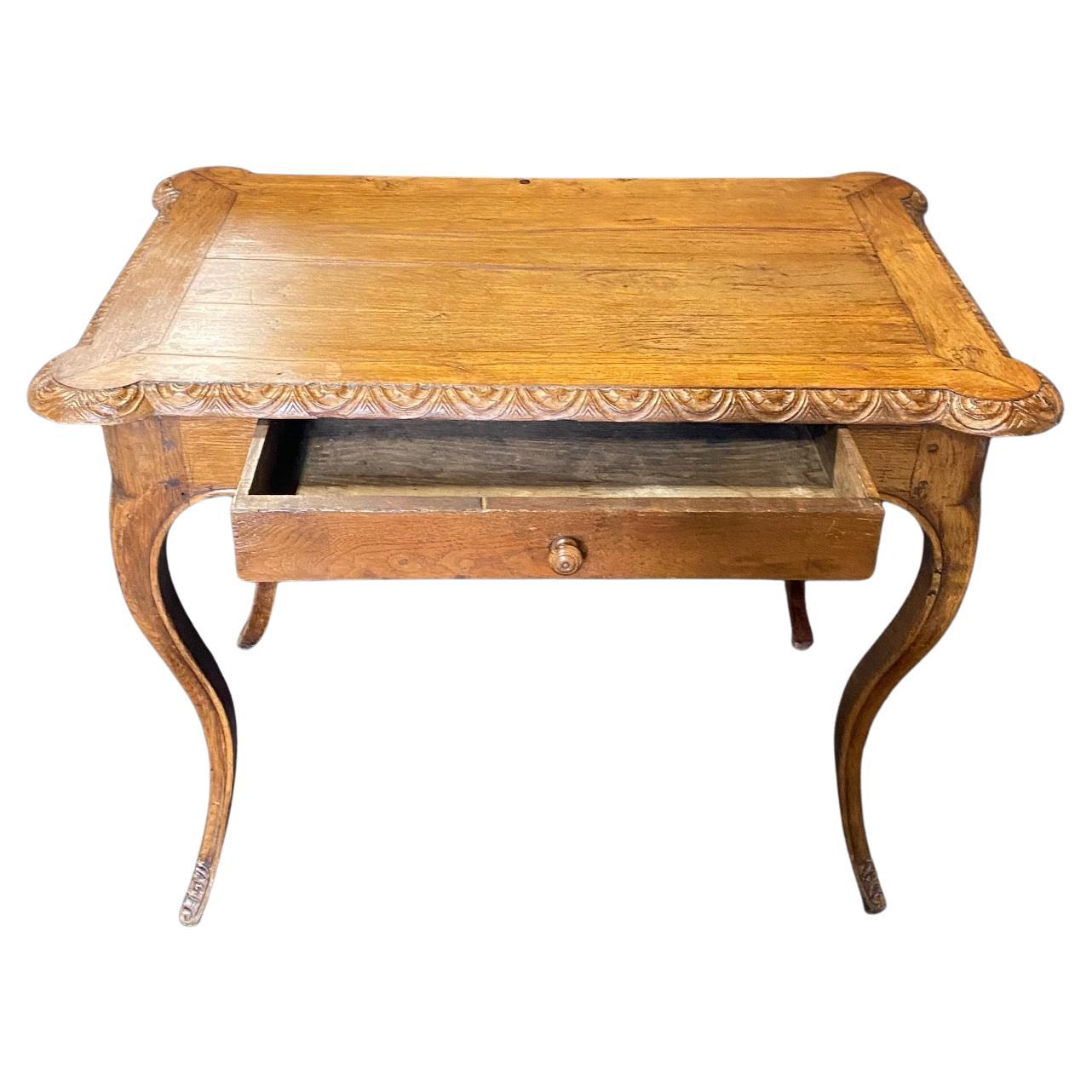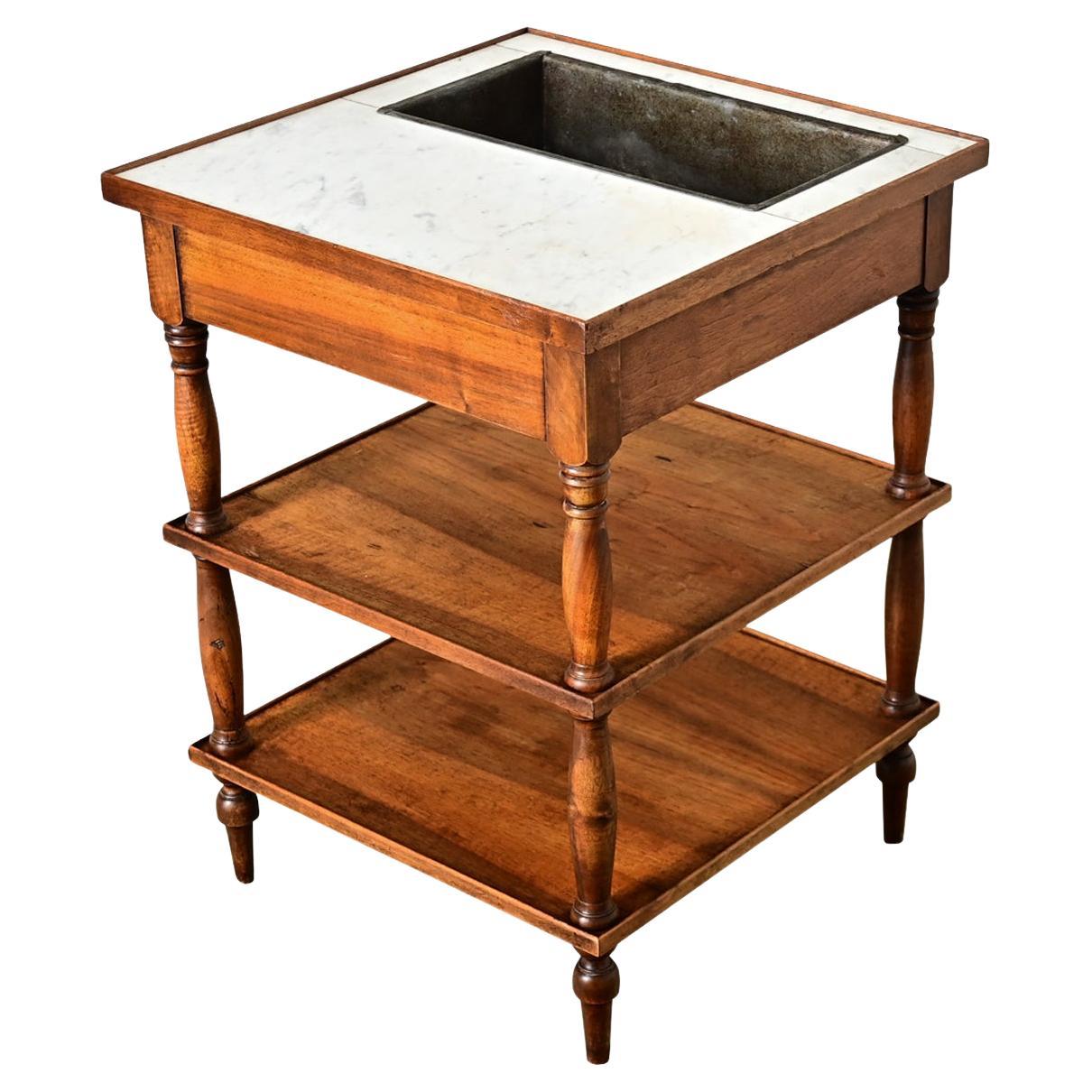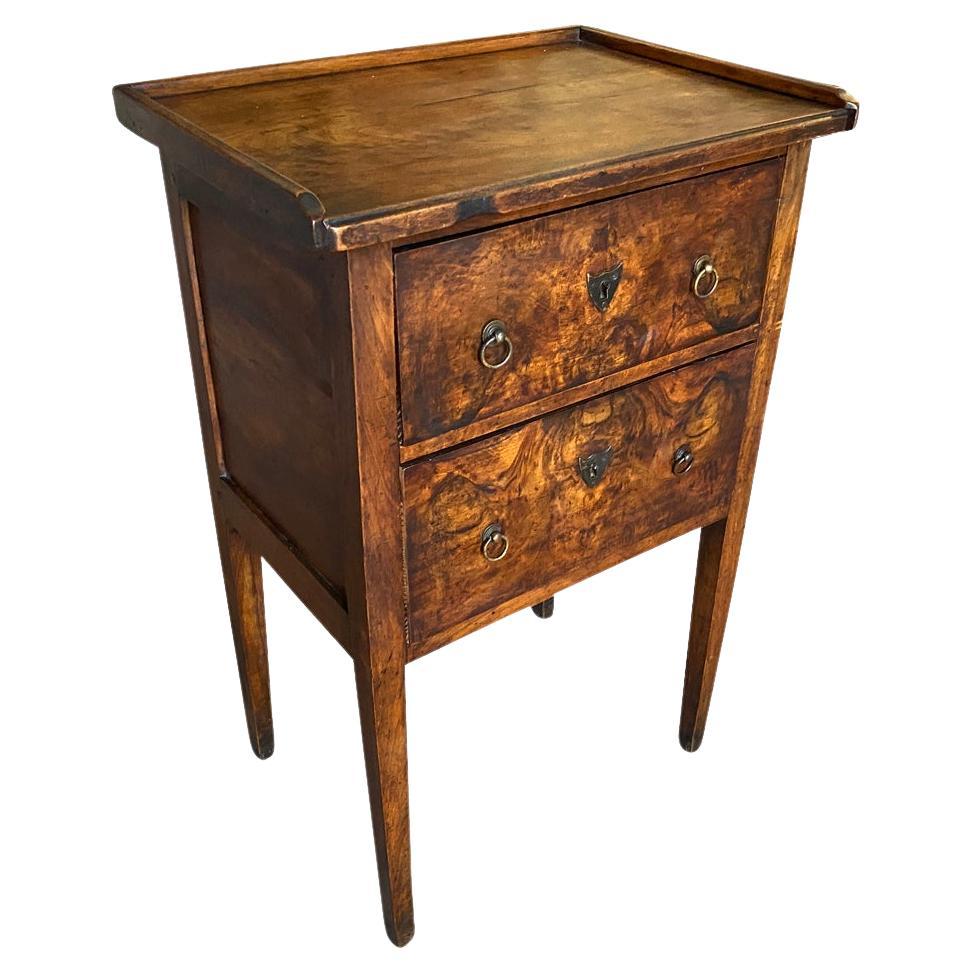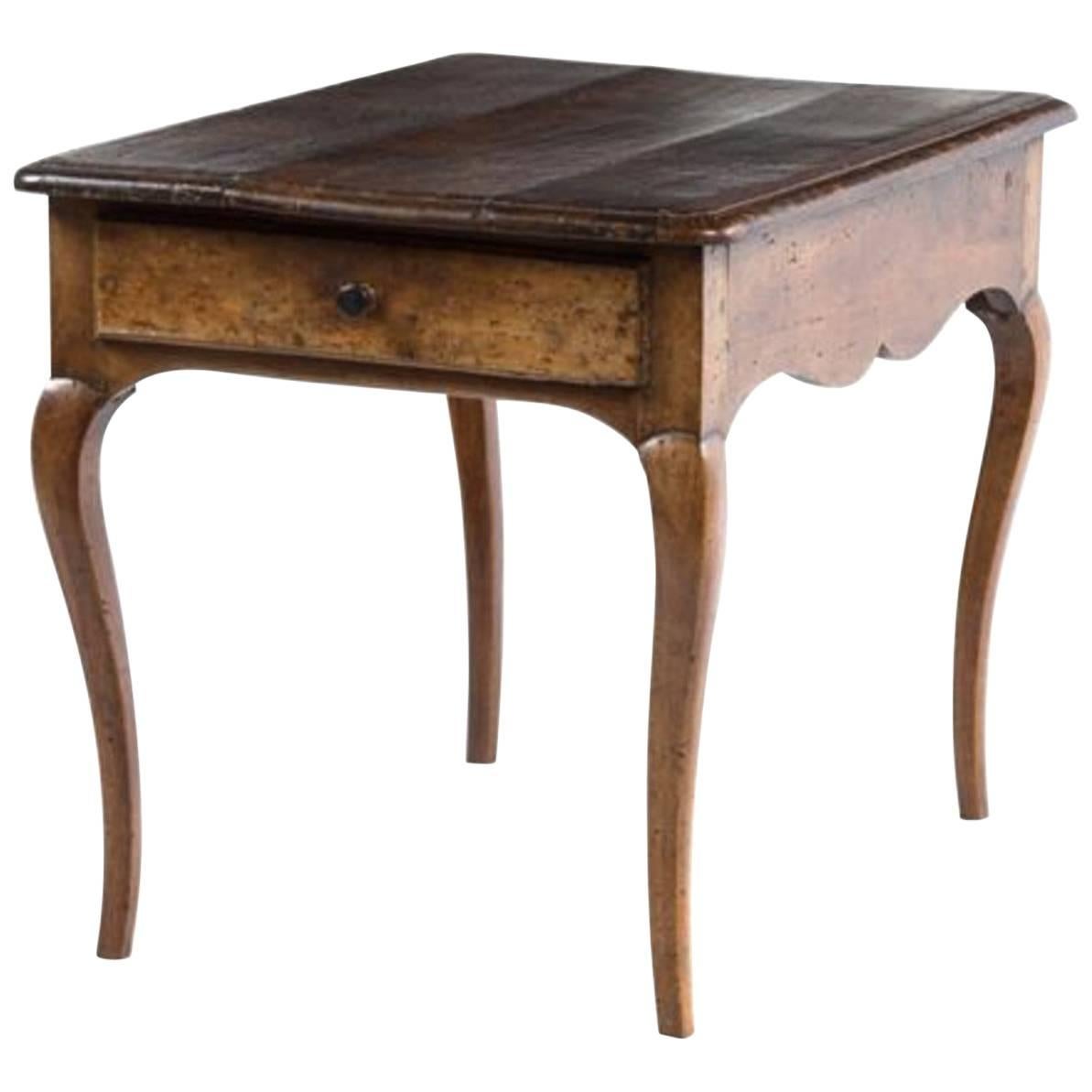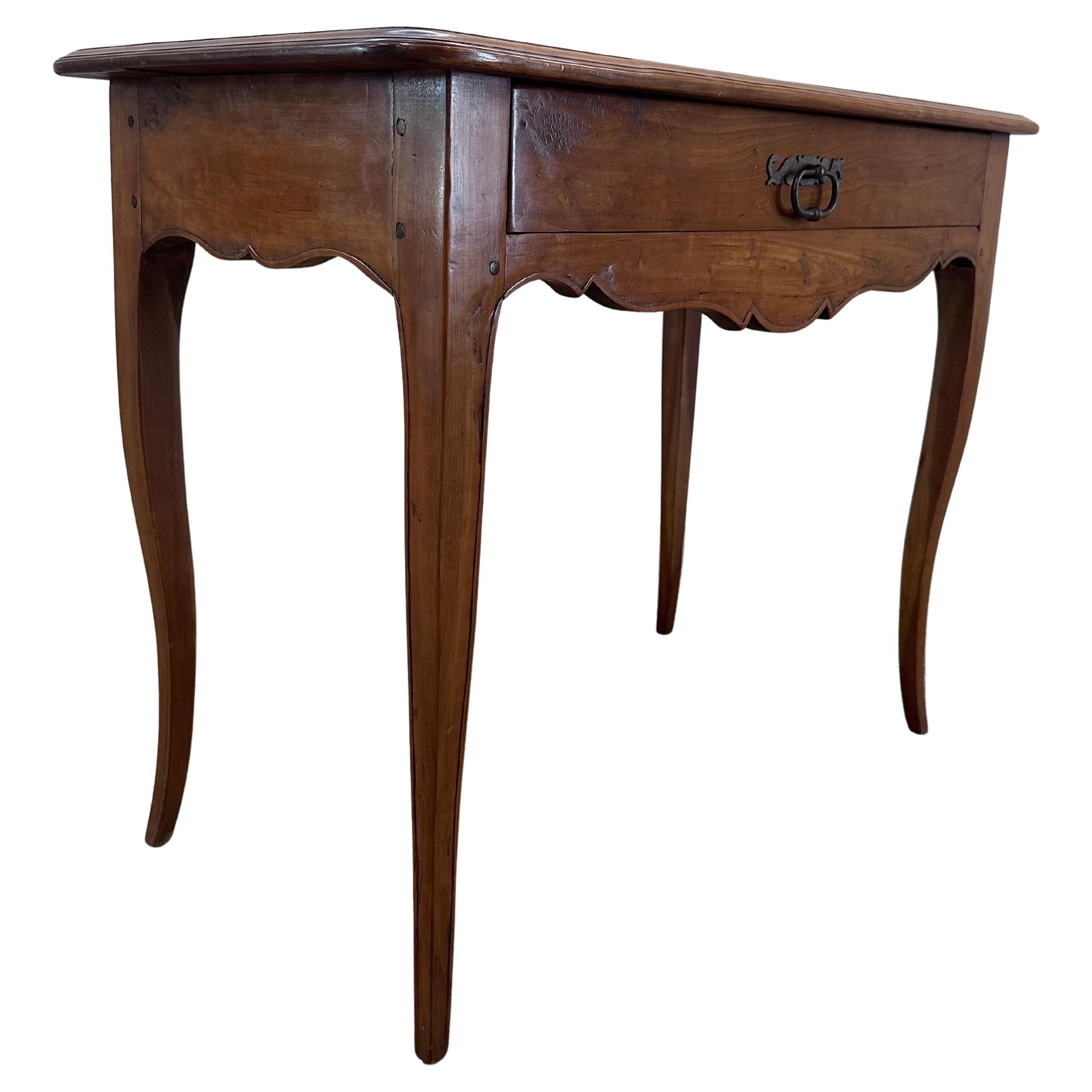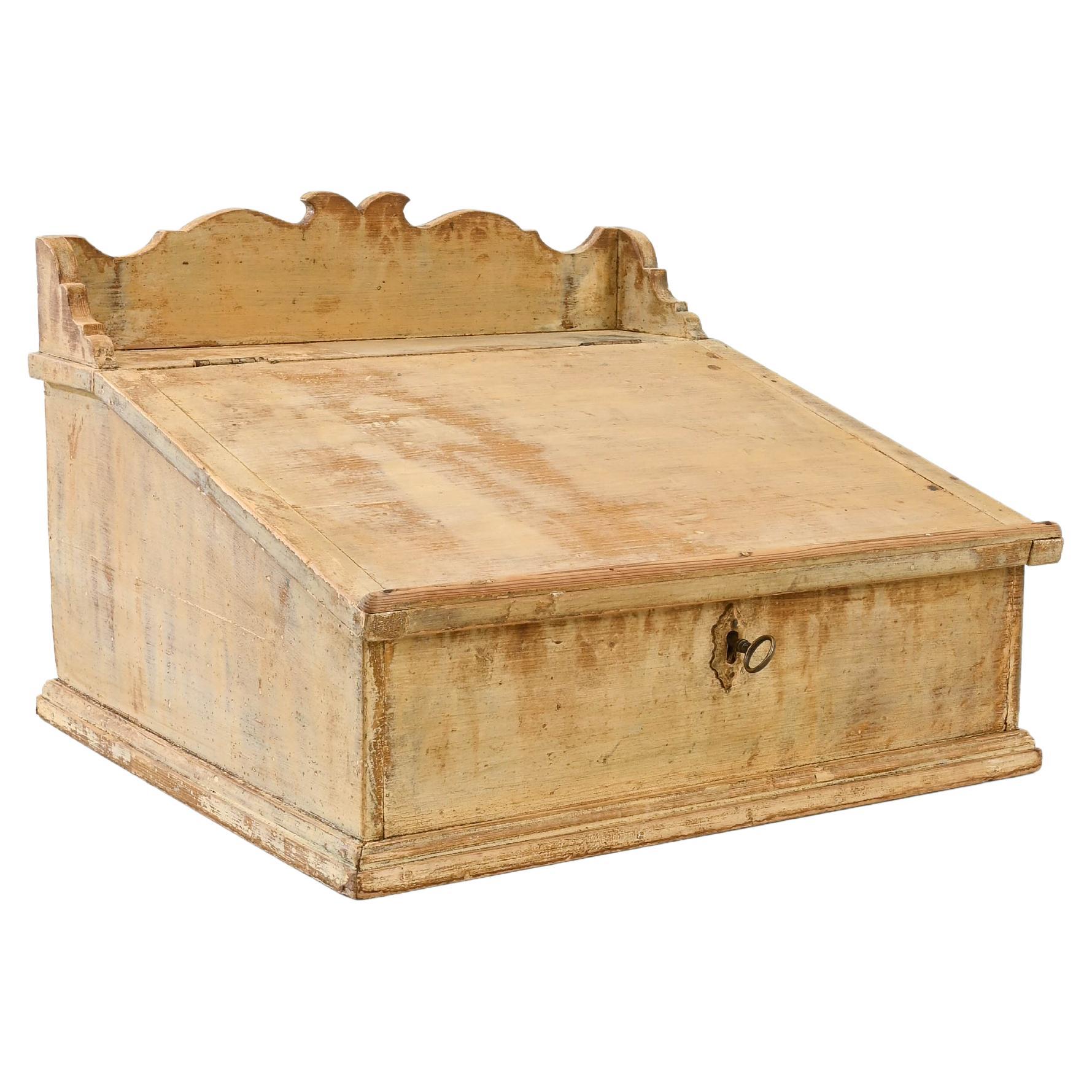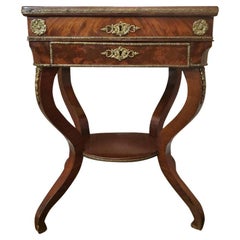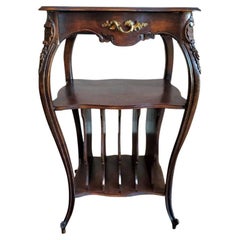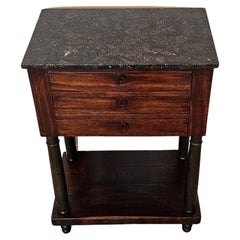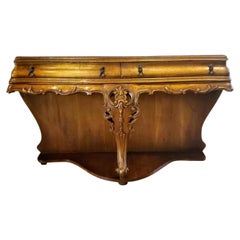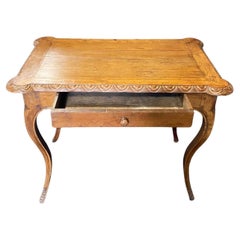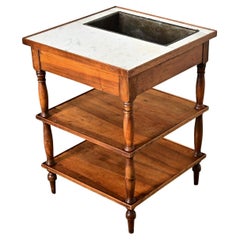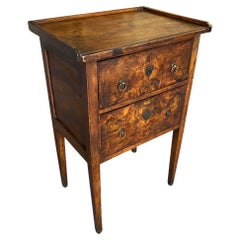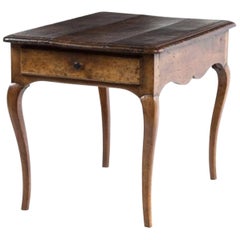Items Similar to 18th/19th Century French Provincial Rafraichissoir Wine Cooler
Want more images or videos?
Request additional images or videos from the seller
1 of 11
18th/19th Century French Provincial Rafraichissoir Wine Cooler
$6,500
£4,884.52
€5,664.94
CA$9,125.03
A$10,125.58
CHF 5,341
MX$123,611.71
NOK 67,574.03
SEK 63,288.55
DKK 42,276.35
About the Item
A scarce antique country French rafraichissoir table (wine cooler) desserte server with beautifully aged patina. Circa 1800
Hand-crafted in Provincial France in the late 18th / early 19th century, having a quality pegged solid wood frame in the original dark red painted finish with gilt accents, partial Rosso Verona marble top with serpentine shaped front, inset rectangular compartment / ice bin / chiller, over a single drawer with hand cut dovetail joinery, over medial shelf, rising on cabriole legs.
Dimensions: (approx)
27.5" high, 30.5" wide, 27" dDeep
Great antique condition with warm rustic patina over the whole. Retaining original antique character marks throughout, including organically distressed chippy paint patina, old restoration to marble top. Wear consistent with age and use.
What is a Rafraichissoir?
Considered an "essential" serving table in 18th century France, the rafraîchissoir did serve a very specific purpose for certain members of French society at the time. Having one of these small refreshment tables parked near the dining table gave French nobility or the bourgeoisie and their guests the opportunity to dine alone — meaning waiters and other domestic servants were not privy to the confidential conversations and rumblings of the rich and famous.
Most often made with a marble top and brass gallery to accommodate spills, rafraîchissoirs (sometimes called servantes) were fitted with two or more wells that held removable brass or silver plated buckets for chilling wine. They also included a drawer for storing corkscrews, cutlery, extra napkins, and anything else that might be needed during dinner. They also had a shelf or shelves below to hold covered dishes or extra plates for later courses, thus allowing the host and his guests more privacy by providing all the required items for the duration of the dinner without the prying eyes and ears of the help.
- Dimensions:Height: 27.5 in (69.85 cm)Width: 30.5 in (77.47 cm)Depth: 27 in (68.58 cm)
- Style:French Provincial (In the Style Of)
- Materials and Techniques:Brass,Marble,Paint,Wood,Gilt,Hand-Crafted
- Place of Origin:France
- Period:Early 19th Century
- Date of Manufacture:circa 1800
- Condition:Repaired: Old restoration to marble top. Wear consistent with age and use. Minor losses. Minor fading.
- Seller Location:Forney, TX
- Reference Number:1stDibs: LU5977232400412
About the Seller
4.8
Platinum Seller
Premium sellers with a 4.7+ rating and 24-hour response times
Established in 2013
1stDibs seller since 2021
294 sales on 1stDibs
Typical response time: <1 hour
- ShippingRetrieving quote...Shipping from: Forney, TX
- Return Policy
Authenticity Guarantee
In the unlikely event there’s an issue with an item’s authenticity, contact us within 1 year for a full refund. DetailsMoney-Back Guarantee
If your item is not as described, is damaged in transit, or does not arrive, contact us within 7 days for a full refund. Details24-Hour Cancellation
You have a 24-hour grace period in which to reconsider your purchase, with no questions asked.Vetted Professional Sellers
Our world-class sellers must adhere to strict standards for service and quality, maintaining the integrity of our listings.Price-Match Guarantee
If you find that a seller listed the same item for a lower price elsewhere, we’ll match it.Trusted Global Delivery
Our best-in-class carrier network provides specialized shipping options worldwide, including custom delivery.More From This Seller
View All19th C. French Charles X Restoration Period Sewing Stand Work Table
Located in Forney, TX
A scarce period Charles X (1818-1834) French Restoration mahogany travailleuse sewing (thread stand - side table - jewelry dressing table) with light, warm, beautifully aged patina.
Born in France in the early 19th century, almost certainly Parisian work, exquisitely hand-crafted, this exceptionally executed example features ornate gilt bronze ormolu mounts, escutcheons, and elaborate gilt metal trim. Having a highly figured light mahogany hinged lid top, lifting open to reveal a striking finished interior with divided compartments and original inset mirror plate. The conforming rectangular case fitted with a faux drawer front over a dovetailed drawer with sectioned interior. Elegantly rising on oval-shaped medial shelf stretcher-joined curvacious legs.
Dimensions (approx):
27" High, 20" Wide, 13.5" Deep
Stunning light almost blonde antique mahogany coloring and mellow warm tone, superb wood grain detail, and charming, beautifully aged patina over the whole. Great shape overall. Retaining original antique character marks, wear consistent with age and indicative of minimal use, nothing that detracts from the aesthetics or functionality, but only adds to the overall authenticity, refined elegant warmth, luxurious sophistication, and cozy unpretentious rustic elegance.
Delivered cleaned, hand waxed, polished French patina finish, ready for immediate use and generational enjoyment!
What is Charles X style:
The comte d’Artois – or Charles X - was the son of the dauphin Louis-Ferdinand de Franc and Marie-Josèphe de Saxe. He succeeded his two brothers Louis XVI and Louis XVIII and became the King of France in 1824. Thirty years after the French Revolution, he wanted to embody the return of monarchy and became the leader of the catholic party . As the previous kings, he was crowned in 1825 but he was soon overthrown by the revolution in July, 1830, called "Trois Glorieuses". He left then for England, Scotland, Prague and Istria where he died in 1836.
Charles X style lasted from 1818 to 1834 and happened during the Bourbon Restoration (French Restoration). This style did not replace totally the style of furniture from the French Empire but it was different from the formalism in the Napoleonic era, during which strictness and simplicity were inspired by Greco-Roman art. Indeed, artistic fields flourished. In terms of furniture, this renewal was suggested by the softening of shapes. Even though the simple aspect from the French Empire was still visible, shapes became curvier with volutes and arabesques. Another distinction is the loss of the massive aspect of furniture and the decrease of dimensions in order to decorate smaller appartments. Handling ability and comfort were key-words in the making of furniture. Apartments had essential elements such as chests of drawers, big rounded tables in the dining room, desks or secretaries, armoires and even dressing tables, comfortable fainting couches in the living room, small tables, pedestal tables, as well as gondola chairs. The wavy aspect of the latters certainly represent Charles X style the best.
One of the most emblematic features of this style is the use of bois clairs – light woods in warm blond tones - and indigenous woods that are varnished in order to highlight the grains. Bird's-eye maple, ash trees, plane trees, yew trees, beech trees, olive trees and cedar trees were most likely to be used. Indeed, at the beginning of the 19th century dark woods were hard to find. In 1806, the Napoleon’s Continental System was established in order to ruin the United Kingdom by preventing the country from any business with the rest of Europe. Therefore craftsmen had to find alternatives from mahogany which was the most commonly used material at this time. After 1815, the import of wood was even more difficult because of peace treaties and the European political situation, which contributed to the popularity of the bois clairs and indigenous woods. The furniture was often decorated with fine inlays made out of dark wood representing foliage, which contrasted with the veneer. Even though these patterns can look like bronze decorations from the Empire era, they were far more simple and did not represent any military or mythological attributes. On the tables, trays were sometimes made out of marble as in the French Empire, but it was often put aside and inlaid veneer, Verre Eglomisé – a type of glass with a mirror finish –, mirror or porcelain from Sèvres or Paris were more likely to be used.
Decorative elements from the Monarchy were highly appreciated again as they suggested luxury. Indeed, marquetry work was particularly fashionable - Boulle marquetry thrived around 1820 as the works of the Levasseur family can show. In the same way, draperies and trimmings referred to the monarchist splendour. Fabrics were often white – the traditional colour of the Bourbons – or light coloured as oppposed to the typical green from the Napoleonic era.
One of the most symbolic figures from this period of time might be Jean-Jacques Werner (1791-1849), a cabinetmaker who worked for prestigious clients such as the Duchesse de Berry who was Charles’s step-daughter. His works can be seen at the Musée des Arts Décoratifs and at the Grand Trianon in the Palace of Versailles. The duchess’s appartments situated at the pavillon de Marsan and at the Palais de Saint Cloud illustrate Charles X style the best with furniture made out of bois clairs and ornamented with dark wood patterns or fine gold decorations.
Chales X style allows a transition between the sobriety of the Empire style and the abundant aspect of Louis-Philippe style. The gothic style started at this time through the "style à la cathédrale", inspired by religious architecture, which thrived from 1827 to 1830. Indeed, at the beginning of the 19th century, Romanticism put the spotlight on the Middle Ages. Cabinetmakers were not inspired by the medieval furniture but rather by architectural elements of churches and cathedrals. For instance the backs of chairs were decorated with arches shaped like rib and serration. In the same way, before Charles X abdicated, pieces of furniture were made out of dark woods – such as mahogany, which was used again in France – and were inlaid with light wood. Romanticism also influenced the layout of furniture in appartments to suggest movement through a mix of various styles, various shapes and various sizes, as opposed to the static aspect of Neoclassicism. The start of industrialisation and mechanisation also influenced this style as early technical developments led to the production of pieces of furniture in series.
Credit:
Marc Maison
Bibliography:
FANIEL Stéphane (Dir.), Le Dix-neuvième Siècle Français, Collection Connaissance des Arts, 1957, Hachette
SASSONE, Adriana Boidi, Furniture from Rococo to Art Deco, 2000, Evergreen
--
Extremely versatile:
As warm and attractive as it is useful, this remarkable antique table having the ideal size and small proportions for a variety of different uses, including as a side table, accent or occasional table, tall sofa...
Category
Antique Early 19th Century French Charles X End Tables
Materials
Bronze, Ormolu
19th Century French Rocaille Louis XV Style Portfolio Stand
Located in Forney, TX
A rare late 19th century carved mahogany French Louis XV style portfolio table / sheet music stand.
Exquisitely handcrafted and elegantly finished in timeless Rocaille taste. A classic representation of the genre, with serpentine shaped molded edge parquetry top of matched diamond pattern inlay, supported by a finely hand carved, scrolled and scalloped apron and single frieze drawer with original asymmetrical gilt ormolu pull, over a conforming contoured shelf and open gallery of vertical slots for sheet music, books, magazines, letters, documents and whatnots, all raised by four long cabriole leg wonderfully carved with complementary motifs.
In excellent condition, exceptional craftsmanship and detail, having warm, rich antique mahogany color...
Category
Antique 19th Century Louis XV End Tables
Materials
Ormolu
Early 19th Century French Empire Period Mahogany Nightstand End Table
Located in Forney, TX
A period French Empire (1804-1815) mahogany chest of drawers nightstand with beautifully aged patina.
Born in France in the early 19th century, hand-crafted of warm rich solid mahog...
Category
Antique Early 19th Century French Empire Night Stands
Materials
Belgian Black Marble
Antique Italian Louis XV Rocaille Style Bombe Demilune Table
Located in Forney, TX
A rare and a little unusual carved gilt wood console table from the early 20th century.
Hand-crafted in Italy, solid wood construction, distressed painted gold lacquered gilded br...
Category
Early 20th Century Italian Louis XV Console Tables
Materials
Giltwood
18th Century Spanish Colonial Church Altar Table now Sideboard Server
Located in Forney, TX
A magnificent rustic Spanish Colonial antique, circa 1725, church altar with remarkable patina and detailing.
Hand-crafted in the first half of the 18th century, most likely commissioned by the Spanish Empire for use in a Colonial religious Mission, now fashioned with later antique elements and repurposed for use as a sideboard.
The scarce Baroque period ecclesiastical architectural church altar presents with a raised gallery shelf back topped with a single board, over a massive, thick pine plank wooden slab top, featuring impressive rich patina, rustic charm and antique character. Mounted over the distinctive architectural trapezoid shaped molded base with rich hand carved and polychrome painted decoration, including the sophisticated original Italian / European inspired trompe-l'œil marbleizing finish, which was a variety of faux painting techniques used only by highly skilled artisans to create the distinctive and varied patterns of marble, in an effort to reproduce the colors, veining and luster of real marble or other building materials. Rising on solid supports enhanced with recessed paneling, smooth rounded corners and edge work and stepped molded trim.
Beautiful, nicely aged patina over the whole, highly desirable heavily worn, naturally distressed, chippy paint craquelure finish that has been stabilized to minimize further loss, that does not detect from the aesthetics or functionality, but only adds to the overall elegant warmth and rich historical depth, that can only be acquired over three centuries. Very strong, sturdy, stable. Delivered cleaned, hand waxed, luminous polished French patina finish, ready for immediate use, and many more years of generational enjoyment.
Dimensions: (approx)
37.25" High, 62" Wide, 27" Deep
The large size, and substantial proportions, make this excellent for a variety of different uses, including as a distinctive buffet table or server, credenza, oversized console, farmhouse kitchen...
Category
Antique 18th Century Central American Baroque Religious Items
Materials
Wood, Pine, Paint
Early 19th Century French Empire Period Bureau a Cylindre Gentleman's Desk
Located in Forney, TX
A exceptionally rare Period French Empire (1804-1814) walnut bureau a cylindre.
Exquisitely hand-crafted in France, most likely Parisian work, dating to the early 19th century, the large antique cylinder desk...
Category
Antique Early 19th Century French Empire Desks and Writing Tables
Materials
Bronze
You May Also Like
Antique 19th Century French Provincial Country Side Table or Petite Desk
Located in Hopewell, NJ
Antique 19th century Louis XV provincial walnut side table or writing desk having a curved rectangular overhanging top with inset center, carved edges and serpentine frieze with cent...
Category
Antique 19th Century French French Provincial Side Tables
Materials
Walnut
French 19th Century Mahogany Rafraichissoir
Located in Baton Rouge, LA
A French mahogany rafraîchissoir table from the late 19th century. Functioning like a dry bar, this occasional table is adapted to keeping beverages cold by placing them in a removab...
Category
Antique 19th Century French French Provincial Side Tables
Materials
Marble, Brass
French Directoire Period Side Table
Located in Round Top, TX
A very beautiful early 19th century Directoire period Side Table from the South of France. Wonderfully constructed from handsome walnut with 2 drawers raised on tapered legs. Gorgeou...
Category
Antique Early 19th Century French Commodes and Chests of Drawers
Materials
Walnut
Charming 18th Century Provincial Side Table
Located in Buchanan, MI
Charming 18th century Provincial side table, great old color and patination. Rectangular top over single drawer raised on cabriole legs.
Category
Antique 18th Century French French Provincial Side Tables
Materials
Wood
Antique French Provencial Side Table With Drawer
Located in Baton Rouge, LA
Purchased by our owner on a buying trip in France 20 years ago, this beautiful table would make a lovely addition to any home.
This is a vintage wooden side or writing table in a cl...
Category
Antique 19th Century French French Provincial End Tables
Materials
Wood
1800s French Antique Patinated Ecritoire
Located in High Point, NC
This antique ecritoire was crafted in 19th century France. A heavily distressed wooden ecritoire, this desk organizer flaunts a spacious case with an elegant slant top and a subtle c...
Category
Antique 19th Century French French Provincial Desks and Writing Tables
Materials
Wood
More Ways To Browse
18th Century Country French Tables
Verona Marble
Ice Bucket Table
French Provincial Marble Table
Table Bin
Antique Chippy
Marble Top Wine Table
Antique Wood Bin
Antique Well Bucket
Country Server
Rosso Verona
French Waiter
Marble Ice Bucket
Antique Wine Server
Corkscrew Legs
Brass Wine Chiller
Antique Rafraichissoir
Antique Solid Silver Ice Bucket
